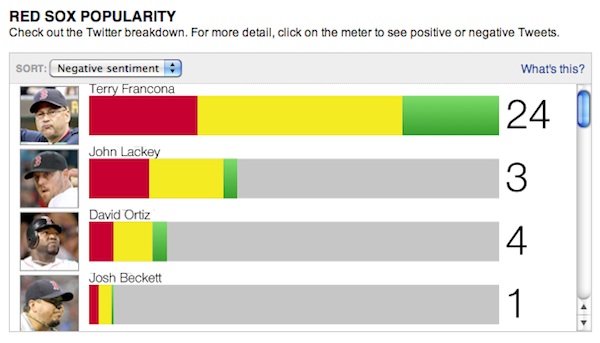
The mood of Red Sox Nation is sour.
Anecdotally, we can guess that baseball fans around Boston are in a foul mood after seeing their team do everything short of set itself on fire after ending the season by losing 18 of its final 24 games. But we also know this thanks to the power of Twitter, which can be a fairly good gauge on people’s opinions, especially in sports.
That’s one of the reasons Boston.com decided to get into the sentiment analysis game with The Pulse, a tool that monitors social data to find moods and trends. They’re partnering with Mullen and Pointslocal to assess and map the data. At the moment, they’re sticking with sports, an area never short of passion or opinion. The mood of Sox fans is as pleasant as stale beer and an old bucket of Popeye’s, so luckily they’ve also launched The Pulse for the 5-1 New England Patriots, and soon the Stanley Cup champion Boston Bruins. (Feel free to insert a joke about sentiment over lack of a Celtics season here.)
“There are volumes of chatter out there,” said Jeff Moriarty, vice president of digital products for The Boston Globe. “If we can help people make sense of what is being said, that helps us fulfill our mission as a publication.”
Boston.com worked with Mullen previously on BrandBowl, a similar social-monitoring project that let the crowd pick the winners and losers of Super Bowl ads. Like the BrandBowl, The Pulse uses #hashtags to pull tweets from the ether, but the algorithm for both also pulls in tweets with other associated keywords — in the case of The Pulse, things like player, coach, and executive names.
The Pulse mixes some of the immediacy of Twitter with the better parts of sports radio: You get the important news and a read on what other fans are talking about, minus the drive-time host and long-winded callers. What’s smart about The Pulse (and what the more sabermetrically-inclined fans may also appreciate) is that it also renders fan perspectives as data — something that can be graphed or mapped for further impact. “There’s a lot of volume of tweeting around sports and teams and it’s easy to parse out,” he said. “It jumped out naturally.”
Moriarty told me that data aspect is what’s most fascinating to Boston.com because it provides opportunities for their reporters, readers, and advertisers. The Pulse could easily be used in reporting as tool for trendspotting — but it could also be a means of tracking reviews for movies or restaurants for readers.
One thing that also makes The Pulse interesting is the location functionality, which at the moment is on a state-to-state scale, but Pointslocal CEO Michael Schlein said will be able to microscope down to the city or neighborhood level eventually. Schlein said the geographic filtering would apply well to other areas like politics, where you could examine sentiment by city, county, or voting district. “It’s a new kind of community, and you can use data to tell a story about what the community is doing,” he said.
The Pulse seems to fit into the growing category of products meant to temper the firehose of Twitter. (You may have heard of a certain heat-seeking Twitter robot called Fuego.) Moriarty sees The Pulse in the same vein. For as much ephemera and commentary exists on Twitter about the future of journalism, there’s plenty more when it comes to sports. “You get a quick sense of it without having to spend a ton of time on social networks,” he said. “There’s so much content out there. It’s a matter of distilling it for people.”
The biggest challenge for The Pulse is how it gains traction with the audience. Do you pitch it as a way of keeping up with the team, as a way of being part of a community on Twitter, or as an extra feature on Boston.com? The Patriots front on Boston.com holds a Pulse widget tracking player popularity, and that widget may soon be embeddable for others, Moriarty said. At the same time Globe sports writers and columnists on Twitter are encouraging readers to get involved through using #pulsepatriot and #pulseredsox.
(Interestingly, the Patriots popularity rankings currently rate Chad Ochocinco as far more popular than Wes Welker. Ochocinco has 2.8 million followers on Twitter, where he’s a social media savant; Welker doesn’t have a Twitter account. But Ochocinco’s season has been a flop, with just nine catches for 136 yards. Welker’s leading the league with 51 catches for 785 yards. Further proof that performance ain’t everything.)
What’s promising about The Pulse is that the more use it gets the better it will become, which could lead to new visualizations, subjects to monitor, or applications, Moriarty said. By next September, hopefully the Sox mood will have improved. Then again, spectacular collapses and thrilling wins both make for interesting data. “The good thing is we’ll have a year-over-year comparison,” he said.